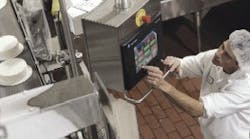"For us, success relied on the integration of the RFID readers into the control architecture," explains Brad Galles, Wells' process controls manager.
|
Wells' Dairy operates the world's largest ice cream manufacturing facility in its home town of Le Mars, Iowa. Cited by industry experts as one of the most technically advanced plants in the industry, the highly automated production lines in Le Mars run up to 160 hours per week.Wells' Dairy knew implementing RFID technology wouldn't be easy, but it also recognized the technology's potential to improve operations and provide a competitive advantage. This meant going beyond simply complying with the Wal-Mart mandate; Wells' saw the potential to re-engineer the supply chain and provide visibility of the product through the production process, as well as the possibility of harvesting data from the production line control system for greater intelligence and improved decision-making. Wells' Dairy wanted to integrate RFID into its existing Rockwell Automation infrastructure for maximum impact and return on investment."The beauty of RFID lies in its ability to add value through increasing plant-floor visibility, which it does by collecting data in a way that's compatible with equipment we already have," says Brad Galles, process controls manager for Wells'. The power lies in the system behind the tag. The RFID tag is linked to a database that holds the production attributes of each ice cream bucket — time, batch ID and production line. With this, Wells' Dairy knows precisely what time every tag was applied and from what batch the pallet was produced."From the outset, we viewed the implementation of RFID technology as a catalyst for making process changes that improve business performance," says Galles. "Once the data is collected, we'll use it to improve inventory tracking, automate many of our quality control and inventory processes and simplify our data collection." Using the wealth of market information available on RFID, Galles and his team of engineers quickly were able to determine the direction they wanted to take with the pilot program. After creating a preliminary outline, Galles began talking to the suppliers — RFID tag and reader companies, automation control suppliers and RFID consultants — each with a different perspective on how to implement RFID. "We knew what we wanted and what direction we didn't want to take," says Galles. "Many suppliers were taking a ‘wait-and-see' attitude in regard to RFID; as a result, many simply focused on short-term ‘slap-and-ship' solutions to meet compliance requirements. If we were going to do it, we were going to do it right the first time. For us, success relied on the integration of the RFID readers into the control architecture." The pilot line at Wells' Dairy became a testing ground not only for the technology as a complete solution for the facility, but also for many of the RFID products themselves. As RFID tag and reader suppliers continuously rolled out new products, it became a challenge for Wells' Dairy to implement a pilot program that delivered reliable, repeatable results, especially within the tight time frame."The truth is, there was very little information that was proven," says Galles. "And the only way to get good, accurate information was to get the equipment and test it in your own facility. As a result, we learned a lot about the technology's capabilities and drawbacks through trial and error."The Rockwell Automation Integrated Architecture was the foundation of Wells' automation and control systems. That included Allen-Bradley ControlLogix controllers, NetLinx networking technology and the ViewAnyWare visualization platform."In order to achieve maximum value for our investment, it was important for us to design the RFID system using the same control platform that our existing processes employ," Galles says.As the first company to implement an RFID application that was seamlessly integrated into its existing control architecture, Galles and his team broke new ground and in doing so drove the development of new technology — an interface module that connected the RFID side of the solution with the control architecture. 

